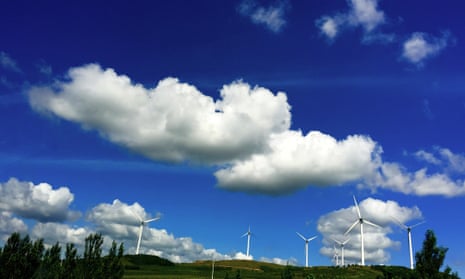The growth of global carbon emissions virtually stalled last year after a decade of rising rapidly, figures published on Wednesday show, just days before world leaders meet in Paris for international talks on climate change.
The slowdown in the growth of the emissions that have caused record-breaking heat in recent years was largely down to China, which bucked its trend of ever-increasing coal use, the Netherlands environment agency said.
Chinese emissions went up 0.9% in 2014, the same amount as the US, as it used more gas for heating. India’s emissions jumped by 7.8% while the European Union’s emissions dropped by an “unprecedented” 5.4%, but the Indian increase was the largest contributor to global emissions growth in 2014 and effectively cancelled out the EU fall.
Together, the four are the world’s biggest emitters, covering 61% of global emissions.
This article includes content hosted on d26adhsj11a4c2.cloudfront.net. We ask for your permission before anything is loaded, as the provider may be using cookies and other technologies. To view this content, click 'Allow and continue'.
Worldwide emissions increased by just 0.5% in 2014, compared to 1.5% the year before, 0.8% in 2012 and an average of 4% a year over the previous decade, when emissions grew dramatically. The slowdown last year occurred despite the global economy growing by 3%, suggesting a “decoupling” between GDP and emissions.
The agency, which is considered one of the world’s top authorities on emissions data, said it appeared the world was moving into a new period of slower growth in emissions. “It is likely that the very high global annual emission growth rates, as observed in the years 2003 to 2011, will not be seen in the coming years,” it said in a statement.
The findings from the environment agency go some way to explaining the negotiating positions that countries and blocs are expected to take in Paris next Monday.
While the EU, US and China are all strongly backing an ambitious climate deal, India was accused at recent G20 talks in Turkey of holding back progress towards a Paris treaty.
The EU’s climate chief, Miguel Arias Canete, told reporters in Brussels that the EU would resist any moves to lower the world’s sights in Paris.
“When you have 196 parties, the easy way out is to agree a minimalistic agreement,” he said on Wednesday. “We will work day and night to have an ambitious agreement that is fit for purpose.” The EU wants to see a legally enforceable protocol that is subject to five-yearly reviews. Canete argued that this would prevent backsliding and provide a mechanism to ramp up climate pledges until the world is on a pathway to global warming of no more than 2C.
Emissions-cutting offers currently on the Paris table would put the world on course for 3C of global warming, according to EU estimates. Scientists believe this could trigger a dangerous escalation of climate instability. “We have to make the 2C [target] operational in the protocol,” Canete said. “We must enshrine it as a global binding objective for all parties.” “This is not something discretionary or a political decision,” he said. “It is science-based.” The bloc is also pushing for a binding benchmark emissions target for 2050.

Comments (…)
Sign in or create your Guardian account to join the discussion